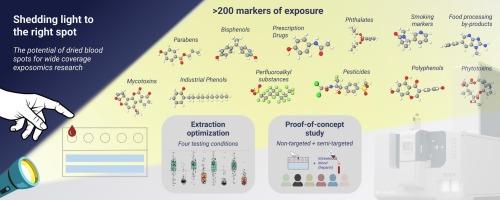靶向和非靶向暴露组学的干血斑分析
IF 9.7
1区 环境科学与生态学
Q1 ENVIRONMENTAL SCIENCES
引用次数: 0
摘要
干血斑(DBS)是一种成熟的样本类型,广泛用于监测新生儿代谢疾病的筛查计划。它们的微创性为评估化学品暴露提供了巨大的希望,特别是在生命早期阶段和大规模流行病学研究中。然而,综合评价关键的分析参数,如提取效率和基质效应跨多种化学类别仍然有限。此外,在DBS小分子组学中,广泛结合靶向和非靶向质谱数据评估的有前途的方法仍未被探索。在这里,我们提出了一种优化的LC-HRMS工作流程,用于DBS样品的暴露组学和代谢组学联合分析。系统地比较了四种提取方案,并对200种结构不同的毒物、污染物和其他关键生物标志物的分析性能进行了评估。优化后的方案对大多数化合物具有可接受的回收率(60-140 %)和重现性(中位RSD: 18 %)。基质效应的中位值为76 %(中位RSD: 14 %)。在一项原理验证研究中,在实际样品中鉴定了具有不同物理化学性质的目标面板的12种暴露化合物,其中有几种是首次在DBS人体生物监测中报告的。补充的非靶向分析进一步扩大了可检测的化学空间,使额外暴露的可靠注释成为可能。此外,对内源性代谢物(包括氨基酸、生物胺、脂肪酸和酰基肉碱)的高置信度鉴定表明,有能力捕获人类代谢组的广泛快照。这些发现支持DBS用于综合暴露组学和代谢组学应用,在前瞻性和回顾性研究中从小体积样本中提供毒理学和生物学见解。本文章由计算机程序翻译,如有差异,请以英文原文为准。

Dried blood spots analysis for targeted and non-targeted exposomics
Dried blood spots (DBS) are an established sample type, widely used in newborn screening programs for monitoring metabolic diseases. Their minimally invasive nature offers great promise for assessing chemical exposures, particularly during early life stages and in large-scale epidemiological studies. However, comprehensive evaluations of key analytical parameters such as extraction efficiency and matrix effects across multiple chemical classes remain limited. Moreover, the promising approach of broadly combining targeted and non-targeted mass spectrometric data evaluation remains unexplored in DBS small-molecule omics. Here, we present an optimized LC-HRMS workflow for combined exposomic and metabolomic analysis in DBS samples. Four extraction protocols were systematically compared, with analytical performance evaluated for >200 structurally diverse toxicants, pollutants, and other key biomarkers. The optimized protocol demonstrated acceptable recoveries (60–140 %) and reproducibility (median RSD: 18 %) for a majority of compounds. Matrix effects showed a median value of 76 % (median RSD: 14 %). In a proof-of-principle study, twelve exposure compounds of the target panel with diverse physicochemical properties were identified in real-life samples, with several reported for the first time in DBS human biomonitoring. Complementary non-targeted analysis further expanded the detectable chemical space, enabling reliable annotation of additional exposures. Moreover, high-confidence identification of endogenous metabolites, including amino acids, biogenic amines, fatty acids and acylcarnitines demonstrated the capacity to capture a broad snapshot of the human metabolome. These findings support the use of DBS for integrated exposomics and metabolomics applications, providing toxicological and biological insights from low-volume samples in both, prospective and retrospective studies.
求助全文
通过发布文献求助,成功后即可免费获取论文全文。
去求助
来源期刊

Environment International
环境科学-环境科学
CiteScore
21.90
自引率
3.40%
发文量
734
审稿时长
2.8 months
期刊介绍:
Environmental Health publishes manuscripts focusing on critical aspects of environmental and occupational medicine, including studies in toxicology and epidemiology, to illuminate the human health implications of exposure to environmental hazards. The journal adopts an open-access model and practices open peer review.
It caters to scientists and practitioners across all environmental science domains, directly or indirectly impacting human health and well-being. With a commitment to enhancing the prevention of environmentally-related health risks, Environmental Health serves as a public health journal for the community and scientists engaged in matters of public health significance concerning the environment.
 求助内容:
求助内容: 应助结果提醒方式:
应助结果提醒方式:


